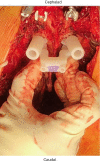Three-dimensional printing versus freehand surgical techniques in the surgical management of adolescent idiopathic spinal deformity
- PMID: 35875617
- PMCID: PMC9263733
- DOI: 10.21037/jss-22-28
Three-dimensional printing versus freehand surgical techniques in the surgical management of adolescent idiopathic spinal deformity
Abstract
Background: Three-dimensional (3D) printed guides are finding increasing applications in the field of orthopaedic surgery and more recently spine surgery. This retrospective cohort study compares benefits and costs of 3D printed guides in surgical treatment of adolescent idiopathic scoliosis (AIS) compared to freehand techniques.
Methods: Intraoperative screw placement was conducted either with 3D printed guides (3D cohort) or traditional freehand technique (freehand cohort) for AIS patients undergoing spinal fusion at a single institution. Patient and perioperative data include: screw placement time, length of surgery, blood loss, hospital stay, spinal curvature correction, total implant costs and training level of surgical assist. Multivariate analysis assessed for confounding and effect modification. P-values <0.05 were considered significant.
Results: There were 29 patients included in analyses, 18 in the 3D and 11 in the freehand (FH) cohort, for a total of 263 3D and 307 freehand screws. Between cohorts, there were no significant differences in patient age (P=0.93), gender (P=0.15), height (P=0.18) or weight (P=0.40). The 3D cohort (mean $26,215, SD =$6,374) had significantly higher implant costs than FH (mean $18,660, SD =$5,587, P=0.003) with significantly reduced intraoperative blood loss (mean 559 mL, SD =273 FH; vs. mean 357 mL, SD =123 3D; P=0.01). On multivariate analysis, surgical residents had significantly faster screw placement times when using 3D guides (P<0.001) than when placing screws freehand. There were no significant differences between cohorts in length of postoperative hospitalization, spinal levels fused, or coronal or sagittal curve correction.
Conclusions: At significant cost, 3D printed guides reduce intraoperative blood loss compared to freehand pedicle screw placement and reduce screw placement time for surgical residents.
Keywords: 3D printing; Adolescent idiopathic scoliosis; resident education; scoliosis; screw guide.
2022 Journal of Spine Surgery. All rights reserved.
Conflict of interest statement
Conflicts of Interest: All authors have completed the ICMJE uniform disclosure form (available at https://jss.amegroups.com/article/view/10.21037/jss-22-28/coif). DAT serves on the wellness committee for the Pediatric Orthopaedic Society of North America (POSNA) and the quality safety and value committee for the Scoliosis Research Society (SRS). DAT also receives money for lectures and teaching from OrthoPediatrics and is a consultant for Depuy Synthes. The other authors have no conflicts of interest to declare.
Figures



Comment in
-
The expanding use of three-dimensional printing in orthopaedic and spine surgery.J Spine Surg. 2022 Sep;8(3):300-303. doi: 10.21037/jss-22-63. J Spine Surg. 2022. PMID: 36285096 Free PMC article. No abstract available.
References
Grants and funding
LinkOut - more resources
Full Text Sources
Miscellaneous
